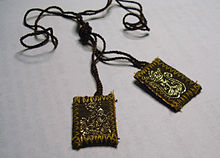വെന്തിങ്ങ

ശരീരത്തിൽ ധരിക്കുന്ന ഒരു അനുഗൃഹീത വസ്തുവാണ് വെന്തിങ്ങ.[1][2]
"മൊണാസ്റ്റിക് സ്കാപ്പുലാർ" എന്ന വസ്ത്രത്തിൽ നിന്നാണ് വെന്തിങ്ങ ആവിർഭവിച്ചത്. ഏഴാം നൂറ്റാണ്ടിൽ സെന്റ് ബെനഡിക്റ്റ് ഓർഡറിലാണ് ആദ്യമായി വെന്തിങ്ങ ഉപയോഗിക്കപ്പെട്ടത്.[3] ധരിക്കുന്നയാളിന്റെ തോളിൽ നിന്ന് മുന്നിലേയ്ക്കും പിന്നിലേയ്ക്കും നീണ്ടുകിടക്കുന്ന ഒരു വലിയ വസ്ത്രമായിരുന്നു ഇത്. ഇതിന് മുട്ടുവരെ നീളമുണ്ടാകും. പല സഭകളിലെയും സന്യാസിമാർ, കന്യാസ്ത്രീകൾ എന്നിവരൊക്കെ ധരിക്കുന്ന വസ്ത്രങ്ങൾ ഇതിൽ നിന്ന് പരിണമിച്ചുണ്ടായതാണ്.[4][5]
ആരാധനയ്ക്കുപയോഗിക്കുന്ന വെന്തിങ്ങ ("ഡിവോഷണൽ സ്കാപ്പുലാർ") വളരെച്ചെറുതാണെങ്കിലും മൊണാസ്റ്റിക് സ്കാപ്പുലാറിൽ നിന്നു തന്നെ രൂപമെടുത്തതാണ്. സന്യാസസഭകളിൽ അംഗങ്ങളല്ലാത്ത വ്യക്തികളാണ് ഇത് ധരിക്കുന്നത്. റോമൻ കത്തോലിക്കാ സഭ വെന്തിങ്ങയെ ഒരു അനുഗൃഹീത വസ്തുവായാണ് (sacramental) കണക്കാക്കുന്നത്. സാധാരണഗതിയിൽ മതച്ഛിഹ്നങ്ങളോ ചിത്രങ്ങളോ ഉള്ള രണ്ട് ചതുരാകൃതിയിലുള്ള വസ്ത്രങ്ങളോ മരമോ കടലാസോ രണ്ട് തുണിനാടകൾ കൊണ്ട് ചേർത്താണ് വെന്തിങ്ങ നിർമ്മിക്കുന്നത്. ഇതിൽ ഒരു ചതുരം നെഞ്ചിലും മറ്റേത് പിറകിലും വരുന്നരീതിയിൽ കഴുത്തിലാണ് ഇത് ധരിക്കുക.[6][7]
അവലംബം
[തിരുത്തുക]- ↑ J L Neve, 2007, Churches and Sects of Christendom ISBN 1-4067-5888-4 page 158
- ↑ Catherine Fournier, 2007, Marian Devotion in the Domestic Church Ignatius Press ISBN 1-58617-074-0 page 18
- ↑ Mackenzie Edward Charles Walcott, 2008, Sacred Archaeology Kessinger Publishing ISBN 978-0-548-86235-3 page 70
- ↑ Andre Vauchez, 2001, Encyclopedia of the Middle Ages, Fitzroy Dearborn Press ISBN 978-1-57958-282-1 page 1314
- ↑ William Johnston, Encyclopedia of Monasticism ISBN 1-57958-090-4 page 310
- ↑ James O'Toole, 2005, Habits of Devotion: Catholic Religious Practice in Twentieth-Century America, Cornell University Press ISBN 978-0-8014-7255-8 page 98
- ↑ Matthew Bunson, 2004, Encyclopedia of Catholic History, OSV Press ISBN 978-1-59276-026-8 page 804
പുറത്തേയ്ക്കുള്ള കണ്ണികൾ
[തിരുത്തുക]സ്രോതസ്സുകൾ
- Rule of St Benedict, ch. 55 (Latin)
- Rule of St Benedict, ch. 55 (English translation)
- John Cassian, Institutes, "On the Dress of the Monks"
ലേഖനങ്ങൾ
- Scapular article from the Catholic Encyclopedia, 1912
- The Scapular and Sabatine Priviledge Archived 2012-07-23 at the Wayback Machine.
- Example of a scapular that forms part of a religious habit (Premonstratensians) Archived 2012-02-14 at the Wayback Machine.
- Example of a scapular that forms part of a religious habit (Dominican friars)
- Example of a scapular that forms part of a monastic habit (Cistercian nuns) Archived 2008-10-21 at the Wayback Machine.
- The Brown Scapular of Our Lady of Mount Carmel Archived 2007-01-09 at the Wayback Machine.
- On the 250th Anniversary of the Giving of the Scapular Message of Pope John Paul II
![]() This article incorporates text from a publication now in the public domain: Catholic Encyclopedia. New York: Robert Appleton Company. 1913.
This article incorporates text from a publication now in the public domain: Catholic Encyclopedia. New York: Robert Appleton Company. 1913. {{cite encyclopedia}}: Missing or empty |title= (help)


